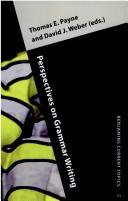| Listing 1 - 4 of 4 |
Sort by
|
Book
ISBN: 0520097742 9780520097742 Year: 1992 Volume: 120 Publisher: Berkeley, Calif. University of California Press
Abstract | Keywords | Export | Availability | Bookmark
 Loading...
Loading...Choose an application
- Reference Manager
- EndNote
- RefWorks (Direct export to RefWorks)
This work is a quantitative discourse study of referential devices in Yagua, a relatively unstudied language of the Amazon basin. Of particular interest are folktales in which the major participants are matched pairs, and which involve extensive use of direct speech. A major finding is that the indices of "Referential Distance" and "Persistence" quantify distinct functional domains.
Yagua language --- Yagua Indians --- Yagua (Langue) --- Yagua (Indiens) --- Discourse analysis --- Grammar --- Folklore --- Analyse du discours --- Grammaire --- Folklore. --- Discourse analysis. --- Grammar. --- -Yagua language --- -Yagua Indians --- -Llagua Indians --- Mishara Indians --- Yahua Indians --- Yava Indians --- Yegua Indians --- Peban Indians --- Yahua language --- Yegua language --- Cariban languages --- Amerindian languages --- Ethnology. Cultural anthropology --- Llagua Indians --- Indians of South America --- Yagua langage --- Yagua language - Grammar. --- Yagua language - Discourse analysis. --- Yagua Indians - Folklore.
Book
ISBN: 9780521763295 9780521757119 0521757118 9780511778988 9780511933356 0511933355 0511778988 0521763290 0511925611 9780511925610 1107217040 0511853173 1282908324 9786612908323 0511931999 0511930658 0511928149 Year: 2011 Publisher: Cambridge Cambridge University Press
Abstract | Keywords | Export | Availability | Bookmark
 Loading...
Loading...Choose an application
- Reference Manager
- EndNote
- RefWorks (Direct export to RefWorks)
"Language is primarily a tool for communication, yet many textbooks still treat English grammar as simply a set of rules and facts to be memorised by rote. This new textbook is made for students who are frustrated with this approach and would like instead to understand grammar and how it works. Why are there two future tenses in English? What are auxiliaries and why are they so confusing? Why are English motion verbs hard to use? Why are determiners so important in English? These and many other frequently asked questions are answered in this handy guide. Student learning is supported with numerous exercises, chapter summaries and suggestions for further reading. An accompanying website offers further resources, including additional classroom exercises and a chance to interact with the author. It is the essential grammar toolkit for students of English language and linguistics and future teachers of English as a Second Language"--Provided by publisher.
English language --- Language and languages --- Grammar --- Study and teaching --- Grammar. --- Study and teaching. --- Foreign language study --- Language and education --- Language schools --- Analysis and parsing --- Diagraming --- Composition and exercises --- Arts and Humanities --- Language & Linguistics --- Language and languages Study and teaching --- Germanic languages --- English language - Grammar --- Language and languages - Study and teaching --- Anglais (langue) --- Grammaire
Digital
ISBN: 9780511778988 Year: 2011 Publisher: Cambridge Cambridge University Press
Abstract | Keywords | Export | Availability | Bookmark
 Loading...
Loading...Choose an application
- Reference Manager
- EndNote
- RefWorks (Direct export to RefWorks)

ISBN: 1282152734 9786612152733 9027292086 9789027292087 9789027222411 902722241X 9781282152731 6612152737 Year: 2007 Publisher: Amsterdam Philadelphia John Benjamins Pub. Co.
Abstract | Keywords | Export | Availability | Bookmark
 Loading...
Loading...Choose an application
- Reference Manager
- EndNote
- RefWorks (Direct export to RefWorks)
Good language descriptions liberally illustrate their claims with examples. The author must select and order examples, and provide accompanying information. The example may include a reference number, the example in multiple forms (phonetic, phonemic, morphemic or morphophonemic, written), brackets and categories, glosses, translation, punctuation, functional annotations, grammatical judgements, subscripts, empty categories, ellipses marking, information about the author and language variety, attention-directing mechanisms, and so forth. Formatting these diverse sorts of information is a non-trivial task; suggestions are given for "best practice." The delivery of documents on screens (rather than on paper) makes possible some dynamic enhancements such as inspecting an example's textual context, toggling on/off various types of information, controlling highlighting and conflation.
Language and languages --- Foreign languages --- Languages --- Anthropology --- Communication --- Ethnology --- Information theory --- Meaning (Psychology) --- Philology --- Linguistics --- Grammars --- Authorship.
| Listing 1 - 4 of 4 |
Sort by
|

 Search
Search Feedback
Feedback About UniCat
About UniCat  Help
Help News
News